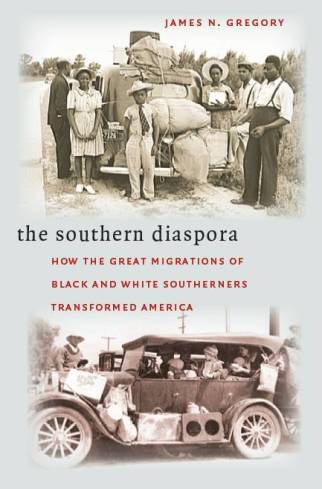Black Metropolis
The paragraphs that follow are excerpted from
The Southern
Diaspora:
How the Great Migrations of Black and White Southerners Transformed America
by James N. Gregory
To understand how the African American exodus changed history we must start with the observation that the migrants were moving into some of the most important places in America, the half dozen or so largest cities. And they were doing so precisely as those cities enjoyed their era of greatest political and cultural authority. New York, Chicago, Detroit, Los Angeles, Philadelphia, Cleveland, Washington DC -- these cities, all but one outside the South, were the chief money centers, media centers, and political centers for early and mid twentieth century America, the place to be for anyone looking for access to those forms of power. Black southerners found ways to influence some of the institutions hosted by these dominant cities and through them gained leverage that eventually, over the course of decades, would be used to shift the nation's systems of racial relations and also regional relations. Key to that evolving influence was a distinct community formation that came together in big northern cities during the second quarter of the twentieth century. Contemporaries called it the “Black Metropolis.”
Until recently it has been difficult for historians to recognize the capacities of the Black Metropolis. The term itself largely disappeared from public discourse by the 1960s, replaced by the concept of the ghetto, a label that evokes images of distressed neighborhoods locked in poverty and lacking in resources and infrastructure. There were good reasons for this terminological shift. Activists and scholars needed to drive home the facts of racial containment and racial inequality in northern spaces. But the ghettoization model was incomplete. Concentrating on what was missing in the way of opportunities, resources, institutions, and political power, it underplayed what was present. Recent historians have found a new balance, substituting what Richard Thomas calls a "community building process" approach for the ghettoization scheme. Without neglecting the context of racism the new studies manage to suggest some of the pride and energy that went into the development of the major urban black communities.
I am going a step further and urging reconsideration of the concept of Black Metropolis. It has utility for a couple of reasons. First it calls attention to the particular setting of the principal black communities--in the major metropolitan areas of the nation. The great cities in their age of maximum greatness yielded black communities that were different than those in other settings. Second, the term Black Metropolis resurrects a celebratory terminology that African American journalists used for several decades before the sociological perspective undercut it.
an excerpt from Ch 4 "Black Metropolis"

The Southern Diaspora: How The Great Migrations of Black and White Southerners Transformed America is the first historical study of the Southern Diaspora in its entirety. Between 1900 and the 1970s, twenty million southerners migrated north and west. Weaving together for the first time the histories of these black and white migrants, James Gregory traces their paths and experiences in a comprehensive new study that demonstrates how this regional diaspora reshaped America by "southernizing" communities and transforming important cultural and political institutions.
Read the catalogue description and advance reviews.
Read the Preface and Introduction.